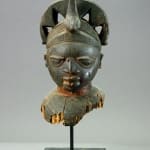Yoruba Wooden Egungun Headcrest, 20th Century CE
Wood
34.3 x 17.8 cm
13 1/2 x 7 in
13 1/2 x 7 in
PF.4682 (LSO)
Further images
This imposing and serene piece is an Egungun headcrest, which the Yoruba of Nigeria carve and use in ceremonies dedicated to honouring dead male ancestors. It is a compact yet...
This imposing and serene piece is an Egungun headcrest, which the Yoruba of Nigeria carve and use in ceremonies dedicated to honouring dead male ancestors. It is a compact yet highly ornate model, with a round integral base (with halted termite damage) ringed with perforations to support a costume. The head is small and round, with a high brow and a rounded chin. The face is understated and serene, the eyes semicircular forms with pierced pupils, the nose wide yet pointed, the lips thick and parallel straight lines. The coiffure is ornate and boxlike, denoted with incised lines. It is surmounted with a sagittal and coronal geometric crest with excised triangles, which in turn is surmounted with a duck (?) whose bill is inside the bill of another bird on the mask’s forehead. The cheeks are scarred with three vertical and three horizontal marks on each side. The ears are pierced. It is dark brownish in colour, with traces of red and paler pigment in the depressed areas, and considerable handling patination.
The Yoruba are a Central Nigerian tribal group, originally descended from a Hausa migration from the northeast in about 900 AD. A small kingdom – Ile Ife – was founded by Oduduwa, followed by great sociopolitical expansion into Southwest Nigeria, Benin, and Togo. The influence of the city was felt far beyond these boundaries, however, and many smaller political entities were held under its sway. Communities were presided over by the Oba (king) and various senates (Ogboni), and councils made up of guild leaders, merchants and the lesser aristocracy (related to the Oba). The Yoruba have an exceptionally rich and diverse mythology, history and religious context, all of which are directly linked to their artistic output; in Yoruba society, this grouped heritage is known as the Itan.
Egungun masks are associated with rituals which honour the collective spirits of deceased ancestor, thus ensuring their benedictions upon their descendents and also to uphold their ancient ethical standards. Large-scale social events are highly complex, with specially-trained priests and initiates to bring out the spirits and pass them into the bodies of the masqueraders. The egungun thus use the bodies of the dancers to symbolically drive out unethical and immoral behaviour that has accrued in the village’s fabric since their previous visit. They also single out specific miscreants for public mocking, using the anonymity of the costume and the solemnity of the occasion to avoid future repercussions.
The masks used to dance at egungun ceremonies (Odun Egungun) or familial variants differ stylistically and conceptually from other Yoruba mask forms such as Gelede and Epa. They are essentially dished bases supporting representations of animals and humans from their shared past, usually expressing a myth or specific leader etc. They thus vary according to village. This specific piece is a classical representation, which doubtless reflects some social truth about the village from which it comes. In our terms, it is a beautiful and unique piece of African art.
The Yoruba are a Central Nigerian tribal group, originally descended from a Hausa migration from the northeast in about 900 AD. A small kingdom – Ile Ife – was founded by Oduduwa, followed by great sociopolitical expansion into Southwest Nigeria, Benin, and Togo. The influence of the city was felt far beyond these boundaries, however, and many smaller political entities were held under its sway. Communities were presided over by the Oba (king) and various senates (Ogboni), and councils made up of guild leaders, merchants and the lesser aristocracy (related to the Oba). The Yoruba have an exceptionally rich and diverse mythology, history and religious context, all of which are directly linked to their artistic output; in Yoruba society, this grouped heritage is known as the Itan.
Egungun masks are associated with rituals which honour the collective spirits of deceased ancestor, thus ensuring their benedictions upon their descendents and also to uphold their ancient ethical standards. Large-scale social events are highly complex, with specially-trained priests and initiates to bring out the spirits and pass them into the bodies of the masqueraders. The egungun thus use the bodies of the dancers to symbolically drive out unethical and immoral behaviour that has accrued in the village’s fabric since their previous visit. They also single out specific miscreants for public mocking, using the anonymity of the costume and the solemnity of the occasion to avoid future repercussions.
The masks used to dance at egungun ceremonies (Odun Egungun) or familial variants differ stylistically and conceptually from other Yoruba mask forms such as Gelede and Epa. They are essentially dished bases supporting representations of animals and humans from their shared past, usually expressing a myth or specific leader etc. They thus vary according to village. This specific piece is a classical representation, which doubtless reflects some social truth about the village from which it comes. In our terms, it is a beautiful and unique piece of African art.







